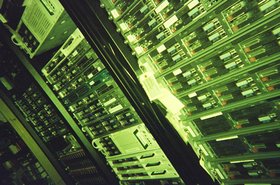A data center is traditionally and most commonly defined by its maximum IT load or the total incoming power supply capacity. Unfortunately, this approach immediately focuses attention on the data center as a large power consumer without communicating either the purpose of the facility or the value it brings. It’s an incomplete and misleading description which invites criticism.
Describing a data center on the basis of its maximum power consumption is comparable to promoting a motor vehicle purely on the size of its engine. There are probably people that would find this approach attractive, but most of us would really like to know what type of vehicle is being described: lorry, bus, van, car, motorbike. And what kind of performance it provides: fuel efficiency, max speed, 0-60 time, number of seats for passengers or maximum load. That way we can understand the capability of the vehicle and whether it’s suitable to meet its expected requirement or not.
Who would be interested in buying a new vehicle if all they knew was that it had a 150bhp engine? Does it have five doors? Does it have three wheels?
Clearly, we do need to be aware of the power consumed by a data center. Global data center electricity demand in 2018 was an estimated 198 TWh, or almost one percent of global final demand for electricity (International Energy Agency, 2019), illustrating the impact of the data center industry on global energy use. However, if we continue to focus the public’s attention on how much power our data centers require without communicating the value they bring, we are inviting criticism.
What metrics are available to describe data centers?
There are a range of physical metrics used to describe data center facilities such as site area, internal floor area or data hall floor area. But again, simply defining a data center facility by its area can lead to the public thinking of such sites as colossal, vacuous wastes of space, let alone energy the energy they consume, once again with no concept of the purpose or benefit of the facility.
Other variants of energy-based metrics such as air throughput and water turnover can also be used. The challenge here is that used in isolation, such metrics promote the energy-hungry nature of a facility, once again without providing any clue as to the value it brings.
This obvious potential for bad press leads us to believe that alternative metrics should be considered to help communicate the scale of a facility in a way more comprehendible to those who fall outside of this growing industry.
How do we go about change?
One option would be to use IT focused metrics such as:
- Data throughput
- Number of servers
- Speed of connection to major population areas
- Data storage capacity
- Total processing power
- Connectivity (number of operators)
The downside here is that the metrics are somewhat technical and abstract, and don’t really communicate the real-world value the facility brings to the person in the street.
If we want to communicate the real benefit of a facility, we need to select a metric that relates to the primary purpose of the facility in a meaningful way. The Table helps to illustrate this approach:
Using this approach would help the data center industry to communicate the primary purpose of specific facilities as well as the capacity of the data center to fulfil its objective, in doing so it removes the focus from the energy being consumed in doing so.
For facilities that perform multiple functions, a combined description could be used e.g., “Facility y will store up to 3 million hours of HD video, 2 million apps and host up to 500,000 simultaneous players for online games.”
As a further extension to this idea, we could also communicate the efficiency of a facility in delivering its primary purpose by using a composite metric to quantify the ‘Benefits’ per unit of ‘Drawbacks.’ With this metric, the ratio should be obvious, the greater the value the better!
Data Center Useful Value = Benefits/Drawbacks
Sounds simple, doesn’t it? But, just deciding on the ‘Drawbacks’ in the ratio also brings a range of options. This could be based on the power consumption of the facility, or could possibly be extended to CO2 emissions (could this be day-to-day or embodied carbon?), or perhaps the ratio could be made relative to the floor area of the building or site?
Can we change the way we communicate data center value?
The advantage of an approach such as this is that we get a real world benefit based efficiency metric rather than using Power Usage Effectiveness (PUE) which communicates how efficiently the facility delivers power to the IT equipment, with no means of communicating whether or not the IT equipment is efficient or performing any valuable work.
All the above seem plausible within specific sectors. However, it may not facilitate an industry-wide data center comparison and could not be directly applied to mixed-use or colocation facilities. At first glance, it doesn’t seem that one single metric to effectively measure a data center’s worth will achieve industry recognition or acceptance any time soon.
In the meantime, I would speculate that what is more likely to happen is the development of a ‘toolkit’ of metrics for use across various applications, to help promote a data center's worth and allow comparison within a sector. Such a toolkit could introduce new-found healthy competition within the industry and may ultimately keep us motivated in moving the industry towards further enhancements in performance whilst reducing overall resource consumption.
I’d be interested in other ideas for evaluating data centers in a way that focusses less on the energy we use and more on the value and efficiency we bring to the connected world. It’s definitely a discussion we need to have.
Arup is a member of the EUDCA.






